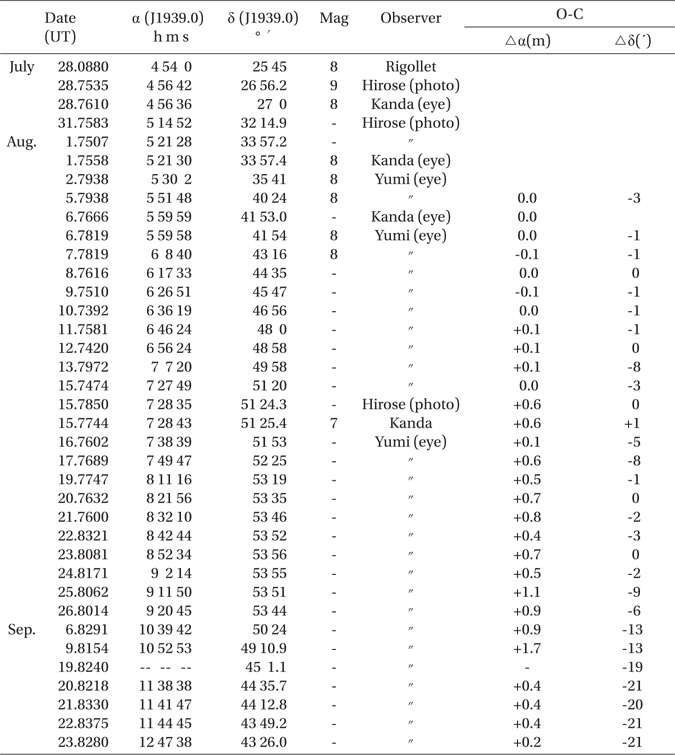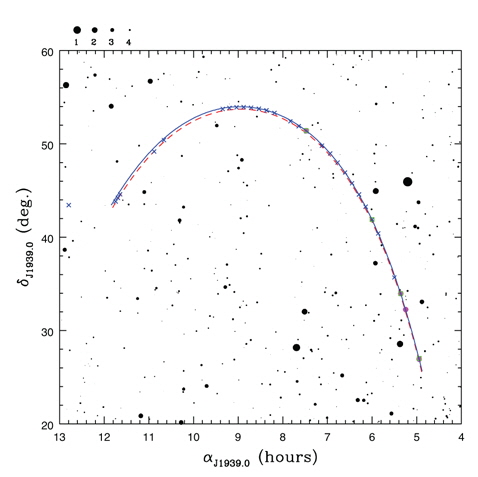



R. Rigollet (Lagny, France) discovered a comet on 28 July 1939, in the northeastern sky just before sunrise (1939 VI or 1939h) and A. Fresa (Turin, Italy) confirmed the comet the next day (Fresa 1939). Since then, there had been many follow-up observations and studies involving orbital calculations for the Rigollet comet (see Kronk 2009 reference therein). As Kronk (2009) pointed out, L. E. Chumpham first suggested that the comet Rigollet is identical with the comet observed by C. Herschel (Slough, England), the sister of W. Herschel, in 1788 (1788 II). Now, the comet is called 35P/1939 O1 or Herschel-Rigollet comet in honor of both discoverers. Recently, Chernitsov & Baturin (2001) determined a unified system of orbital elements of the Herschel-Rigollet comet using all available observations. However, observations of the comet from East Asia have never been introduced into previous studies. In 1939, S. Yumi (Incheon, Korea) also observed the Rigollet comet in the Incheon Meteorological Observatory of Korea using a 6-inch refractor telescope and published his data in Japanese journals.
2. INCHEON METEOROLOGICAL OBSERVATORY
In 1904, Japan established temporary meteorological observatories in several Korean cities including Incheon, Busan, and Wonsan. Six years later, during the Japanese occupation of Korea, the Incheon Meteorological Observatory became the headquarters of the meteorological observatories located in Korea (hence, interchangeably called The Observatory of the Government-General of Korea), and replaced the functions of Gwansanggam, the Royal Bureau of Astronomy and Meteorology, of the Joseon dynasty in Korea. Although the main task of the observatory was meteorological observations, it also published each year an astronomical almanac, as well as a handbook for daily use. For details on the astronomical activities of the observatory, refer to Lee et al. (2011). According to the handbook of the year 1930 (The Observatory of the Government-General of Korea 1929), a 5 m astronomical dome was constructed at the Incheon Meteorological Observatory in 30 March 1929, and a 6-inch equatorial telescope was installed in the dome six months later. In the 1920s, another telescope of the same diameter was used at Choson Christian College (now Yonsei University) of Korea. However, the second telescope seems only to have been used for educational purposes.
As mentioned above, Yumi published his observational data of the Rigollet comet in two Japanese journals: the Bulletin of the Observatory of the Government-General of Korea (Yumi 1939) and the Publication of the Lecture on Meteorology (Yumi 1940). However, the contents of the two papers were the same. From his paper, we know that a telegram regarding the appearance of two comets was received from Copenhagen Observatory: the Rigollet comet (1939 h) discovered on 28 July, and the Kaminsky comet (1939 i) on 31 July. Regarding the latter comet, Yumi stated that it was unobservable in Japan and Korea on account of bright moonlight and a cloudy sky. In addition, the latter comet was below the horizon just after sunset. Yumi clearly pointed out that Hirose and Kanda of the Tokyo Astronomical Observatory performed follow-up observations of the Rigollet comet on 28 July 1939, presumably using a 95 cm telescope, and introduced some of their observations in his paper. It is known that a telescope of 95 cm diameter was used in the Tokyo Astronomical Observatory of Japan (now the National Astronomical Observatory of Japan). Hence, we think that these Japanese astronomers should be credited as the first confirmers of the Rigollet comet, rather than A. Fresa.
In Table 1, we present all the transcribed observational data of the Rigollet comet presented in Yumi’s work. The first column is a calendar date (UT) for the year 1939. The second, third, and fourth columns are right ascension, declination, and magnitude, respectively. As can be seen in the third column, the observations of Hirose and Kanda are given one-tenth order of arc-minute in declination. Meanwhile, Yumi gives the same order of degrees for the last six observations (i.e., since 9 September). In the handbook for daily use for the year 1930 (The Observatory of the Government-General of Korea 1929), however, the resolution of the telescope of the Incheon Meteorological Observatory was 5 s and 1′ in right ascension and declination, respectively, when a Vernier caliper is used. The fifth column in Table 1 is the family name of the observer, together with the observational method (photographic (photo) or naked-eye (eye) observation). Presumably, Hirose took the photo of the Rigollet comet using the 95 cm telescope. However, it is known that all the photographic data in the Tokyo Astronomical Observatory was destroyed during World War II (Soma 2009). The last two columns show the differences in right ascension and declination, respectively, compared with those derived from the orbital elements of Kanda (see Table 2).

Observational data of the Rigollet comet at Incheon Meteorological Observatory (Yumi 1939).

Summary of the orbital elements of the Rigollet comet from this and other studies. All elements are given in the epoch of J1939.0
4. PRELIMINARY ORBITAL ELEMENTS
In general, the methods of Laplace, Gauss, and Olbers are used for the determination of the orbit of a comet or minor planet. The method of Gauss is based on Newton’s laws of motion, as with other methods, but uses the
As can be seen in Table 1, Yumi observed the Rigollet comet for around 28 days. Based on his observations, we calculated the preliminary orbital elements of the Rigollet comet using a modified Gauss method (Marsden 1985, 1991, see also Lee et al. 2009) and presented the results in Table 2, along with the results of Kanda and Nakano (2005). In Fig. 1, we depict the orbital path of the Rigollet comet together with the observation points listed in Table 1. To convert coordinates into the epoch of 1939, we use the algorithms of Meeus (1998) and the proper motion values of Perryman et al. (1997). In the figure, the solid and dotted lines show orbital paths using our preliminary and Nakano’s (2005) orbital elements, respectively. Circular, rectangular, and cross symbols represent the observations of Hirose, Kanda, and Yumi, respectively. As can be seen in Fig. 1, as well as in Table 2, the two orbital paths show good agreement with each other, and with observational data except for that from 23 September. We think that 12 h in right ascension (see Table 1) on this day is a typo (should be 11 h) because ~15 degrees is too large a move for one day, particularly one month after passing the perihelion.
We calculate the differences between the observations of Yumi (but not Hirose or Kanda) and the orbital path of Nakano, and found on average, differences of 0.29 m and 1.95′ in right ascension and declination, respectively. These values are smaller than the differences derived by Yumi using the orbital path of Kanda (0.43 m and 7.15′ in right ascension and declination, respectively), because the orbital elements of Kanda were determined using data observed near the time of perihelion.
When Rigollet discovered his comet, it was just before sunrise. Therefore, a follow-up observation on the same day was impossible in European countries and was made by Fresa in next day. However, the observation was possible in East Asian countries and was done by Hirose and Kanda at the Tokyo Astronomical Observatory in Japan. On the other hand, Yumi, a Japanese astronomer, observed the Herschel-Rigollet comet for 28 days since August 2 at the Incheon Meteorological Observatory of Korea using a 6-inch telescope. Nonetheless, the activities of Japanese astronomers regarding with the Rigollet comet have never been introduced to astronomical societies. Hence, we expect that this study is used for refining the orbital elements of the Rigollet comet by an expert on orbital calculation, although Yumi’s data have relatively poor resolution.


